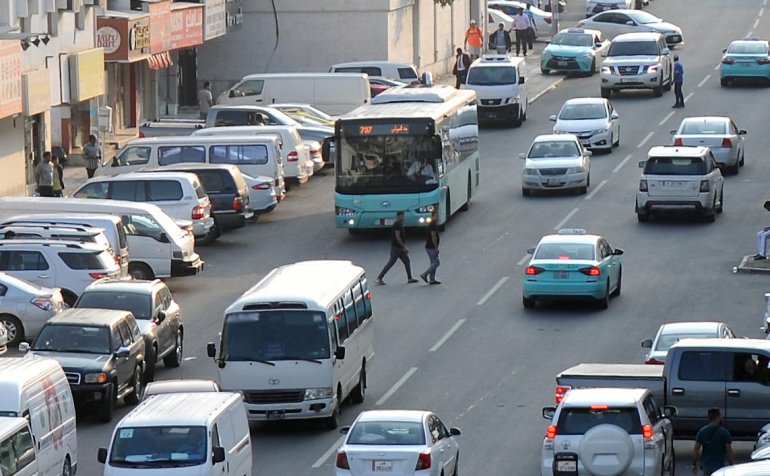
Doha: The Ministry of Interior will start recording violations of traffic rules by pedestrians from tomorrow (August 1) and will start imposing fines in a move to “preserve lives and strengthen discipline in the streets.”
As per the traffic law, there will be three types of penalties. In case the pedestrian is walking on the median (middle of the carriageway) or not using pavements (sidewalk) where available or not walking on the far edge of carriageway opposite the direction of traffic in the absence of pavements, they will face a fine of QR 100.
If the pedestrians are not taking the required precautions or not using designated areas to cross the road, the fine will be QR200.
A fine of QR 500 will be levied in case pedestrian doesn’t follow traffic signals while crossing the road at the intersection and when traffic police allow vehicles to move. The same amount will be charged if any-one breaks through military parades and processions.
Qatar has achieved remarkable successes in traffic safety winning international accolades and awards, especially with regard to reducing road accident mortality, which fell from 16.6 deaths per 100,000 in 2006 to 4.9 cases per 100,000 last year and is lower than the 2022 National Road Safety Strategy goal.
The Assistant Director of Traffic Awareness Department Lt Col Jaber Mohammed Odeiba told Qatar News Agency (QNA) that Qatar has already achieved important milestones in road safety.
Obeida stressed that the idea of implementing the provisions of traffic law for a pedestrian is not to register fines, but to preserve lives and to organize the roads in order to bring our cities to modern stand-ards and reduce the confusion and disruption of traffic due to a pedestrian crossing.
Traffic statistics reflect the risks of a pedestrian crossing. Although the death percentage from run-over accidents in Qatar declined over the past years, it remains high compared to the significant reduction in the overall rate of road deaths.
The deaths from run-over accidents in 2011 were 32, out of a total of 205 deaths in traffic accidents, and no significant change was recorded in deaths of run-off accidents during 2012 and 2013.
The year 2014saw the lowest number of fatalities - 24 out of 228 - but the number rose the year after to 27 out of 227 cases.
While the number of road traffic fatalities dropped to 178, 177 and 167 from 2016 to 2018, run-off accidents remained at 29, 32 and 27 for the three consecutive years.
According to studies carried out by the General Directorate of Traffic, several reasons contribute to run-over accidents, including lack of pedestrian infrastructure such as tunnels and bridges, lack of traffic lights used by pedestrians, lack of lighting in a number of areas and highways, as well as lack of speed bumps that limit speed especially in front of schools, mosques and residential neighborhoods, poor traffic awareness, wrong transit and other reasons.
Odeiba told QNA that the General Directorate of Traffic is determined to take all measures specified in the law to reduce the number of deaths and injuries resulting from run-over accidents, which have already been implemented to address the causes contributing to such incidents.
Officer at Traffic Studies and Research Department, First Lt Abdul Rahman Al Aawi pointed out that despite decline in accidents in recent years, there is a set of recommendations that must be taken into account in order to achieve the goal of reducing traffic accident deaths, including run-over accidents according to the goals and objectives of the traffic safety strategy 2013-2022.
Al Aawi said during a seminar held recently that the recommendations made by the administration and the relevant authorities to provide more pedestrian crossings and the establishment of more separation lines in the main streets and highways to prevent the indiscriminate crossing and planning of the pedestrian corridors are being implemented.
Al Aawi also referred to other projects, some of which are ready and others that are being implemented, such as increasing the area of sidewalks in crowded pedestrian roads and placing metal barriers in non-transit areas.
In an integrated vision to offer a safe passage for pedestrians, Qatar has embarked on its comprehensive pedestrian crossing plan to reduce the mortality of run-over accidents. This plan is one of the components of the integrated transport system for 2030.
The plan takes into consideration the rights of all road users, including motorists, cyclists and people with special needs, which contributes to the preservation and safety of lives and property and, most importantly, the development of a safe movement of pedestrians.
Odeiba pointed out that the implementation of the provisions of Traffic Law on Pedestrian Offenses comes at a time when the state has completed many new road projects that guarantee secure pedes-trian crossings. There won't be any recording of violations on streets that don't meet the necessary conditions to enforce the law.
